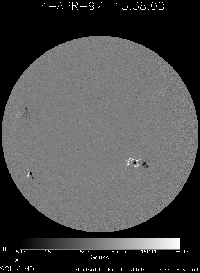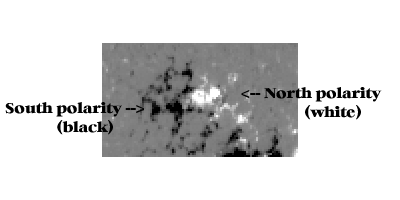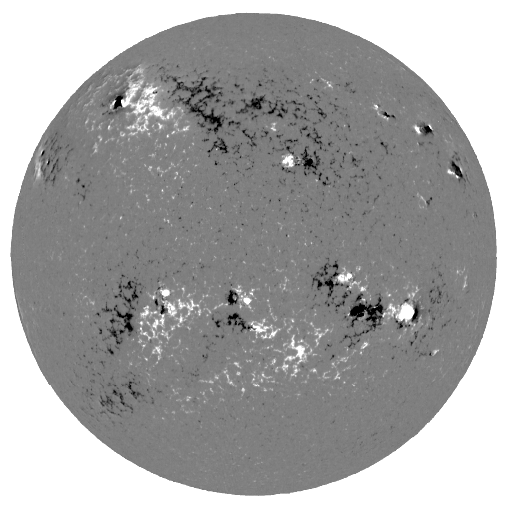Magnetograms
Solar
Magnetograms


The Sun -- a Magnetic Star
Magnetograms
A magnetogram is not a "picture" of the Sun which you might
see with your eyes. Rather, it's an image taken by an instrument
which can detect the strength and location
of the magnetic fields on the Sun.
In a magnetogram, grey areas indicate that there is no
magnetic field, while black and white areas indicate regions where there
is a strong magnetic field. (Any colors could have been chosen;
the grey-black-white is just a common convention, or choice.)
Magnetograms show "line-of-sight" magnetic fields (that is,
those either coming directly towards us or going away from us).
The darkest areas are regions of "south" magnetic polarity
(inward directed, or moving toward the center of the Sun)
and the whiter regions "north" (outward directed, moving
toward us) polarity.



The above magnetogram shows the surface distribution and polarity of the
Sun's magnetic fields and sunspots at a very active time during
its sunspot cycle. When the Sun is very active.
the number of sunspots as at a maximum, and
solar magnetism is dominated by large biopolar sunspots
within two parallel bands oriented in the east-west direction.
Compare this image with the one at the top of the page,
which was taken during a solar minimum, or low magnetic
activity period.
At times of solar minimum,
there are very few large sunspots,
and only tiny magnetic fields can be seen all over the
disk (black and white tiny dots).

Why Do Sunspots Show up on Magnetograms?
Sunspots are essentially evidence of magnetic "eruptions" on the Sun,
or places where the Sun's many complicated magnetic fields break
the "surface" and show themselves.
Although sunspots are sometimes described as magnetic storms,
they are actually relatively calm regions -- the
concentrated magnetism acts as a filter or valve, choking off the heat
and energy (and thus the visible light) flowing outward from the solar
interior. The strong magnetic fields in sunspots inhibit the convection
currents that usually carry hot material from the Sun's deeper layers, so
less convective heat bubbles up within them. The intense magnetism
acts like a refrigerator, keeping sunspots dark and thousands of degrees
cooler (albeit still very hot) than the turbulent gas around them.
And since it is cooler,
a sunspot gives off less light than the adjacent areas.
In fact, the darkest and coolest parts of sunspots are the sites of the
most intense magnetic fields.
Sunspots generally group together in pairs to form the poles of solar magnets.
One sunspot of each bipolar pair has positive ("north", or
outward -directed) magnetic polarity.
Its partner has the opposite negative ("south", or inward-directed)
polarity.
Look at the groups of bipolar sunpots in the active sun image above.
Notice that each spot group seems to contain black and white members.
Notice too that the groups are usually oriented
roughly parallel to the Sun's equator.
A sunspot group's opposite magnetic poles are joined together by
magnetic loops that run between them, rising in arches like bridges that
connect the bipolar magnetic islands. Think of these magnetic loops as
similar to the magnetic field lines which join the Earth's north and
south magnetic poles or the field lines which join the ends of
a bar magnet.
If these loops occur on the edge, or limb, of the Sun, we can
sometimes catch a glimpse of the big ones, which appear as prominences.
Unlike the Earth, the Sun contains a vast
collection of magnetic fields, constantly moving and changing, with the
fields "popping out" of the Sun's surface at the sunspot groups.

Seeing Magnetic Fields?
The fields and forces of magnetism are invisible, so how can we
"see" them?
When an atom is placed in a magnetic field, it acts like a tiny compass,
adjusting the energy levels of its electrons.
If the atom is aligned in the direction of the magnetic
field, the
electron's energy increases. If it's aligned in the opposte
direction, the energy decreases.
Since each energy change coincides with a change in the wavelength of
light emitted by that electron, a spectral line emitted at a single
wavelength by a randomly oriented collection of atoms
in the presence of a magnetic field becomes a group of
3 lines of very slightly different wavelengths.
In addition, the light of each of these divided wavelengths has a
preferred orientation, or circular polarization, that depends on the
direction or polarity of the magnetic field.
So, using a spectrograph, you can measure the spectral line splitting
(the "Zeeman effect") described above, and you can use a polarized
filter to determine both the strength and the direction of the
magnetic field. Stanford's
Michelson-Doppler Imager (MDI)
on board the SOHO spacecraft
is such an instrument. And the magnetograms you will be studying tomorrow
are being collected by MDI right now!


Much of the information for this section is summarized
from Kenneth R. Lang, Sun, Earth and Sky,
Springer, ISBN 3-540-58778-0, 1995.
| 




